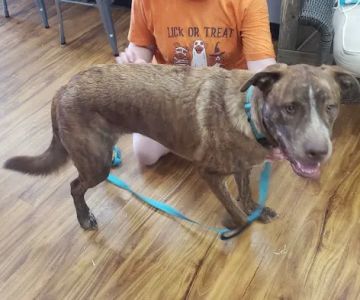Understanding the Root Cause of Your Dog's Jumping Behavior
As a pet owner, you’ve likely experienced the excitement of your dog jumping up when you come home or when they’re just overly enthusiastic. While it's a common behavior, it’s not always the most desirable. Dogs tend to jump in excitement as a way of greeting us, showing affection, or simply expressing their energy. However, this behavior can quickly become a problem, especially when your dog’s jumping starts to annoy guests or even cause injury. If you're wondering how to get your dog to stop jumping in excitement, you're not alone. Let's dive into some practical and effective ways to manage this behavior.

1946 S Christopher Columbus Blvd, Philadelphia, PA 19148, USA
See DetailsWhy Do Dogs Jump in Excitement?
Dogs jump because they’re trying to get closer to your face or to show you that they’re excited. It's a natural behavior, especially for dogs that have a lot of energy. When a dog jumps, they may not be trying to be rude, but rather, they’re showing enthusiasm or seeking attention. For puppies, jumping can also be a way to get noticed, especially in a household with multiple people or pets.
It’s important to remember that while jumping is often harmless, it can quickly escalate into an unwanted behavior if not addressed early. If your dog is jumping on guests or strangers, it can create an uncomfortable or even unsafe environment. Therefore, it's essential to train your dog to stop jumping, especially if you want to maintain control over their behavior in social settings.
Effective Tips for Stopping Your Dog's Jumping
1. Ignore the Jumping Behavior
One of the simplest and most effective methods to stop your dog from jumping is to ignore them when they jump. Dogs are social animals and love attention, so if you give them attention by petting or talking to them when they jump, you're actually reinforcing the behavior. The next time your dog jumps, simply turn your back and avoid eye contact. Wait until they have all four paws on the ground before giving them any attention. This teaches your dog that jumping will not get them the attention they crave.
2. Teach the 'Off' Command
The "off" command is a simple but powerful tool for discouraging jumping. Start by getting your dog to sit down, and when they jump up, use the "off" command in a calm but firm voice. After they respond by stopping the jump, reward them with a treat or praise. Consistent practice will help your dog learn that staying on the ground is more rewarding than jumping. This method also reinforces positive behavior.
3. Reward Calm Behavior
It’s easy to forget to reward calm behavior when you're focused on stopping the jumping. However, rewarding your dog when they remain calm, especially in exciting situations, can significantly reduce the frequency of jumping. For instance, when someone enters your home, instead of waiting for them to jump, reward your dog when they stay seated or keep all paws on the ground. This teaches your dog that calm behavior gets rewarded, making it more likely that they will behave accordingly in the future.
4. Use a Leash for Control
If your dog tends to jump when you're not in control of their movements, using a leash can help you maintain control. When you’re preparing to greet someone or during moments of excitement, gently guide your dog’s movements by holding the leash and preventing them from jumping. This gives you more control over their behavior and allows you to reinforce training techniques more effectively.
5. Be Consistent with Training
Consistency is key when it comes to dog training. If you only correct your dog’s jumping behavior sometimes, they will become confused and less likely to learn the desired behavior. Make sure that everyone in your household is on the same page when it comes to stopping the jumping. The more consistent you are with training, the quicker your dog will learn that jumping is not an acceptable behavior.
What to Do When Guests Arrive
Having guests over can be a trigger for your dog's jumping behavior. The excitement of new people entering the house often leads to a flurry of jumping. To prevent this, make sure your dog is calm before allowing them to greet guests. Consider having your dog stay in another room or on a leash while guests are arriving. Once they are calm and all four paws are on the ground, allow them to greet your guests, but only when they are behaving appropriately.
Additional Considerations for Training Your Dog
It’s also important to consider your dog's breed, age, and temperament when training them. Some breeds, like Labrador Retrievers, tend to be more exuberant and prone to jumping, while others may naturally be calmer. If your dog is older or has health issues, consider adjusting your training approach to account for their physical abilities.
If you're having difficulty with your dog’s jumping behavior despite your best efforts, seeking the help of a professional trainer may be beneficial. A trainer can offer tailored solutions and work with you to ensure your dog is behaving appropriately in various situations.
In summary, getting your dog to stop jumping in excitement requires patience, consistency, and positive reinforcement. By using these tips, you can help your dog learn to greet people calmly and create a more enjoyable and controlled environment at home. Remember, training takes time, but the results will be worth it for both you and your furry friend!










